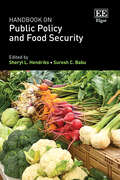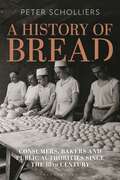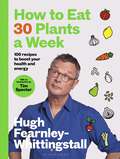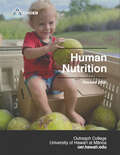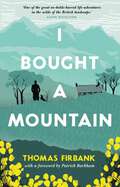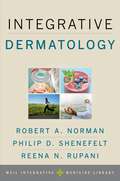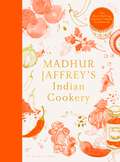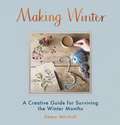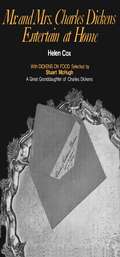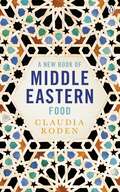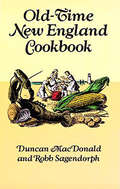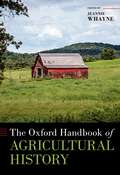- Table View
- List View
Handbook on Public Policy and Food Security
The Handbook on Public Policy and Food Security provides multi-disciplinary insights into food security analysis across the Sustainable Development Goals (SDGs). As food security is an essential outcome and a part of sustainable and healthy food systems, this Handbook addresses the urgent need to provide a comprehensive overview of the field’s current developments.Paired chapters focuses on a specific SDG in turn, presenting an overview and using qualitative and quantitative methodological approaches to assess the impact of food security on the attainment of the specific goal, and the evaluation of the impact of the goal on food security. This Handbook brings together experts in the field who advocate for a food systems approach, highlighting how various components of a food system function together to achieve the goal of food security for all. The cross-policy themes covered extend beyond the SDGs, proving relevant for public policy and food security in the foreseeable future. This erudite Handbook will be highly informative for academics, researchers and students in agricultural economics, development studies, human geography, human rights and comparative social policy. It will also be beneficial for professionals working in public policy, NGOs and multilateral organisations who are interested in understanding food security and nutrition monitoring.
A History of Bread: Consumers, Bakers and Public Authorities since the 18th Century (Food in Modern History: Traditions and Innovations)
by Peter ScholliersFor a long time, everything revolved around bread. Providing more than half of people's daily calories, bread was the life-source of Europe for centuries. In the middle of 19th century, a third of household expenditure was spent on bread. Why, then, does it only account for 0.8% of expenditure and just 12% of daily calories today?In this book, Peter Scholliers delves into the history of bread to map out its defining moments and people. From the price revolution of the 1890s that led to affordable and pure white bread, to the taste revolution of the 1990s that ushered in healthy brown bread, he studies consumers, bakers and governments to explain how and why this food that once powered an entire continent has fallen by the wayside, and what this means for the modern age. From prices and consumption to legislation and technology, Scholliers shows how the history of bread has been shaped by subtle cultural shifts as well as top-down decisions from ruling bodies. From the small home baker to booming factories, he follows changes in agriculture, transport, production and policy since the 19th century to explain why bread, once the centre of everything, is not so today.
How and When to Be Your Own Doctor
by Isabelle A. Moser Steve SolomonDr. Isabelle A. Moser and Steve Solomon collaborated on How and When to Be Your Own Doctor. When Solomon reached his late thirties, he began looking for healthy alternatives. He met Moser and began the practice of a yearly fast to cleanse his body. This book contains their combined knowledge on healing. Topics include How I Became a Hygienist, The Nature and Cause of Disease, Fasting, Colon Cleansing, Diet and Nutrition, Vitamins and Other Food Supplements and The Analysis of Disease States--Helping the Body Recover.
How to Eat 30 Plants a Week: 100 recipes to boost your health and energy
by Hugh Fearnley-Whittingstall'I love the way Hugh inspires us to eat more of the good stuff, and he's done it again brilliantly here.' JAMIE OLIVER'Hugh translates the exciting science of the gut microbiome into something practical and easy. His beautifully diverse, plant-rich recipes are good for us and for the planet.' POPPY OKOTCHAWith an introduction by Tim Spector, bestselling author and founder of ZOE30 plants may sound a lot, but in Hugh's expert hands it feels like an easy win, for the delicious meals as much as the incredible health benefits. Central to these is great gut health, and a foreword by gut-health guru Tim Spector explains why Hugh is bang on target to deliver the goods. And in racking up the plant power, you'll feel great, have renewed energy and reset your microbiome. In chapters such as Six-packed Soup and Stoups, Seven in the Oven, Fish Fivers, Meat and Many Veg Mains and Triple Treat Sides, Hugh shows you how to get many more plants on your plate, with people-pleasing plant-only dishes at the fore, as well as some humdingers with a little well-chosen meat or fish along for the ride. By plants, Hugh means fruit and veg and much more besides – including nuts, seeds, pulses, grains, herbs, spices, chocolate and even coffee.Recipes include: · Purple shakshuka· Shroomami stoup· Sichuan aubergine with tofu and black beans· Caponata with chickpeas and apricots· Tomato and saffron baked rice· Slow-roast Merguez-spiced shoulder of lamb· Steak, charred lettuce and spring onion salsa· Roast ratatouille mackerel fillets· Kimchi (or Kraut) slaw· Very berry ripple fro-yo... and many more!With plant ingredients numbered by chapter, and overlaps kept to a minimum, it's easy to keep a count and rack up your weekly plant score. Simply by choosing just a handful of recipes from the book, you will have nailed your 30 plants, and by adding an extra main, a treat or a pud, and a snack or a side, you'll be well on your way to 50 plants a week! With Hugh to show you the way, this isn't just going to be doable: it's going to be easy, it's going to be fun, and most of all it's going to be delicious.
How to Kiss Goodbye to Ana: Using Eft In Recovery From Anorexia
by Kim MarshallDo you struggle with Ana (anorexia) or have a difficult relationship with food and body image? Emotional Freedom Techniques (EFT) have the potential to transform your life and put you on the path to recovery. Here, honest diary extracts relay Kim Marshall's own struggles with anorexia and bulimia, including time spent in a residential treatment centre, and how she discovered EFT and learned to quiet the negative voices that were blocking her recovery. Now fully-recovered and a certified EFT practitioner, Kim explains how to use the approach as a self-help tool. Including easy-to-follow EFT scripts and positive mantras to help you stay on the path to recovery, Kim explains how to use EFT to help overcome denial and fears about recovery from anorexia. This candid account of recovery from eating disorders shows how it is possible to deal with underlying emotional issues and achieve a more positive mindset.
Human Nutrition
by University of Hawai‘i at Mānoa Food ScienceThis textbook serves as an introduction to nutrition for undergraduate students and is the OER textbook for the FSHN 185 The Science of Human Nutrition course at the University of Hawai'i at Mānoa. The book covers basic concepts in human nutrition, key information about essential nutrients, basic nutritional assessment, and nutrition across the lifespan. <p><p>Revised 2022
I Bought a Mountain
by Thomas FirbankWITH A FOREWORD BY PATRICK BARKHAMAnd an essay by Welsh hill farmer, Dafydd Morris-Jones'I first saw Dyffryn in a November gale... the old house was quivering under the thrusts of the wind, and the wild, remote setting had already captured my fancy, and I will hold it till I die.'So begins the remarkable story of a 21-year-old man who, with no experience in agriculture, visited a sheep farm on a near barren Welsh mountainside in 1931 and that same day bought all 2,400 acres along with its 3000 sheep for £5,000.Set amidst the rugged grandeur of Snowdonia, I Bought a Mountain follows the struggles and triumphs of this impulsive but hard-working man and his every-bit-as-tough wife, Esme, as they fight to build the farm into prosperity.Firbank's writing is guileless and immediate and ruthlessly honest. His paean to the traditional, Welsh hill-farming way of life, transports you to a disappearing world, one ruled by the age-old rhythms of work, weather, livestock and a love of the land, and offers precious insights into conservation and sustainability.
Kitchen knives (Large Print)
This is an image of three kitchen knives. The blades are pointing towards the top of the page and the handles are at the bottom. There is a locator dot shown, which will be at the top left of the page when the image is the correct way up. There are two rivets on each knife handle to secure them to the blade. The sharp edges are to the right of each knife.Test your tactile skills: - Can you find the bread knife with the serrated edge blade?- Find the small paring knife.- Which is the longest knife, the bread knife or the chef's knife on the right of the page?
Kitchen knives (UEB Contracted)
This is an image of three kitchen knives. The blades are pointing towards the top of the page and the handles are at the bottom. There is a locator dot shown, which will be at the top left of the page when the image is the correct way up. There are two rivets on each knife handle to secure them to the blade. The sharp edges are to the right of each knife.Test your tactile skills: - Can you find the bread knife with the serrated edge blade?- Find the small paring knife.- Which is the longest knife, the bread knife or the chef's knife on the right of the page?
Kitchen knives (UEB Uncontracted)
This is an image of three kitchen knives. The blades are pointing towards the top of the page and the handles are at the bottom. There is a locator dot shown, which will be at the top left of the page when the image is the correct way up. There are two rivets on each knife handle to secure them to the blade. The sharp edges are to the right of each knife.Test your tactile skills: - Can you find the bread knife with the serrated edge blade?- Find the small paring knife.- Which is the longest knife, the bread knife or the chef's knife on the right of the page?
Leek (Large Print)
This is an image of a leek standing vertically in the middle of the page. There is a locator dot shown, which will be at the top left of the page when the image is the correct way up. The leek is a member of the Allium family, which includes garlic, onions, shallots and scallions. At the top centre of the page are the leaf tips. There are lines on the image that represent the fine channels running the length of the leaves. The leaves overlap each other and at the bottom of the page, they form a solid bulb, from which the plants roots grow. The plants colour changes from dark green at the top to white at the bottom of the page where the leaves are covered with soil during growth.
Leek (UEB Contracted)
This is an image of a leek standing vertically in the middle of the page. There is a locator dot shown, which will be at the top left of the page when the image is the correct way up. The leek is a member of the Allium family, which includes garlic, onions, shallots and scallions. At the top centre of the page are the leaf tips. There are lines on the image that represent the fine channels running the length of the leaves. The leaves overlap each other and at the bottom of the page, they form a solid bulb, from which the plants roots grow. The plants colour changes from dark green at the top to white at the bottom of the page where the leaves are covered with soil during growth.
Leek (UEB Uncontracted)
This is an image of a leek standing vertically in the middle of the page. There is a locator dot shown, which will be at the top left of the page when the image is the correct way up. The leek is a member of the Allium family, which includes garlic, onions, shallots and scallions. At the top centre of the page are the leaf tips. There are lines on the image that represent the fine channels running the length of the leaves. The leaves overlap each other and at the bottom of the page, they form a solid bulb, from which the plants roots grow. The plants colour changes from dark green at the top to white at the bottom of the page where the leaves are covered with soil during growth.
Madhur Jaffrey's Indian Cookery
by Madhur JaffreyThe 40th-anniversary edition of the beloved classic book on Indian home cooking, with 11 new recipes and gorgeous illustrations.Originally published in 1982, Madhur Jaffrey's Indian Cookery was the book that accompanied the TV series that inspired a generation to cook real Indian food, not the watered down version of it that had persisted in Britain for years.Now, this stunning updated edition - featuring 11 new recipes and a foreword celebrating the 40th anniversary - will inspire even more home cooks to make real Indian food at home. Recipes include classic dals, curries, chutneys and breads, as well as countless lesser-known traditional recipes and techniques to master Indian cooking for all occasions. Madhur Jaffrey's Indian Cookery is a classic cookbook from a trusted and authoritative voice, ready for the next generation to discover these delicious, authentic, failsafe Indian recipes that have stood the test of time.
Making Winter: A Creative Guide for Surviving the Winter Months
by Emma MitchellBanish winter blues and embrace the frosty months by cosying up with Emma Mitchell’s nature-inspired collection of crafts.From delicate silver jewellery, paper-craft decorations and crocheted mittens, to foraged infusions, delicious recipes and nature diaries, Making Winter is filled with projects designed to fend off dreariness in the winter months. Step-by-step instructions and beautiful photographs, shot at Emma’s cottage in the Fens, take you through each project, so that even beginners can enjoy the mood-boosting benefits of a craft-filled winter and snuggle down in their own cosy paradise.
Mr. and Mrs. Charles Dickens Entertain at Home
by Helen CoxMr. and Mrs. Charles Dickens Entertain at Home presents an account of the life of Mr. and Mrs. Charles Dickens told in a series of parties, or "Occasions", given in their own homes. With each is given the lists of distinguished guests; a Victorian Menu taken from Kate Dickens's book What Shall We Have for Dinner?; and a matching one for use today. Recipes for carrying out both types of Menu follow each "Occasion". The book begins with the first dinner party of their married life in 1836 and ends with the completion of the book in 1852. Each chapter follows a quartet theme, with a repetition of four pages right through to the end. The first page of the quartet gives the date of the party (sometimes approximately), the home at which it was given, the guests present, and the life story. The second and third pages are devoted to matching Menus and recipes; and the fourth is an extract from Dickens's own works, chosen by his great granddaughter, Mrs. Stuart McHugh.
A New Book of Middle Eastern Food: The Essential Guide to Middle Eastern Cooking. As Heard on BBC Radio 4
by Claudia Roden'Meticulously collected, compellingly assembled, lovingly told ... informative, delectable and incredibly useful' Yotam OttolenghiClaudia Roden's A Book of Middle Eastern Food is your ultimate cookbook and guide to the rich and exotic recipes of the Middle East . . . As heard on BBC Radio 4's new 5-part series. First published in 1968, Claudia Roden's bestselling classic Book of Middle Eastern Food revolutionized Western attitudes to the cuisines of The Middle East. Containing over 500 modern and accessible recipes that are brought to life with enchanting stories, memories and culinary wisdom, this book takes readers on a cook's tour of countries including Syria, Lebanon, Egypt, Turkey, Greece and Morocco. Inside there's a delicious array of dishes to try: Hot Stuffed Vine Leaves, Sweet and Sour Aubergine Salad, Courgette Meatballs, Persian Lamb, Moroccan Tagine with Fruit and Honey, Hummus, Tabbouleh, Turkish Delight and Coconut Orange Blossom and Lemon Cake. Now in this beautiful new edition, Roden's timeless work will continue to inform and inspire as the next generation of cooks discovers its riches. 'Roden's great gift is to conjure up not just a cuisine but the culture from which it springs' Nigella Lawson
Old-Time New England Cookbook
by Robb Sagendorph Duncan MacDonaldGood old-fashioned home cooking is the keynote of this treasury of classic New England cuisine. Included are over 300 wholesome, easy-to-prepare recipes including Nantucket scallop chowder, chicken pot pie, Boston baked beans, Connecticut stuffed baked salad, apple pan dowdy, Rhode Island johnnycake, mincemeat pie, Parker House rolls, Boston cream pie, lobster five ways (boiled, baked, broiled, fried, and Newburg), Yankee pot roast, and many more.Arranged as a "seasonal cookbook," this book is designed to serve you as a sort of culinary calendar, providing useful food preparation hints and information on a day-by-day basis. The recipes call for fruits, vegetables, meat, and fish available during each season, and dishes are specially chosen to be suitable to seasonal temperatures. Moreover, the recipes are accompanied by charming observations on New England weather and the appropriateness of various foods and dishes to the time of the year.A final section contains favorite recipes from 41 famous New England inns: The Red Lion Inn, Stockbridge, Massachusetts; The Dog Team Tavern, Middlebury, Connecticut; Christmas Farm Inn, Jackson, New Hampshire; and many more. Staples of New England kitchens for generations, the dishes in this unique guide will be welcomed by anyone who delights in time-honored traditional culinary fare.
Orange (Cross Section) (Large Print)
This is a labelled image of an orange shown in horizontal cross section (cut through from side to side). There is a locator dot shown, which will be at the top left of the page when the image is the correct way up. The orange is shown in centre of the page. The roughly triangular shapes of the segments in cross section are arranged around the centre of the fruit. In each segment, near the centre of the image, there is a pip (seed) shown. This will not always be the case as many varieties have been bred to be seedless. The skin or peel of the orange comprises soft pith covered by a thin layer, commonly known as zest; it contains fruity, aromatic oils and is often used by chefs to add citrus notes to dishes. The orange can vary from six to twelve centimetres in diameter.
Orange (Cross Section) (UEB Contracted)
This is a labelled image of an orange shown in horizontal cross section (cut through from side to side). There is a locator dot shown, which will be at the top left of the page when the image is the correct way up. The orange is shown in centre of the page. The roughly triangular shapes of the segments in cross section are arranged around the centre of the fruit. In each segment, near the centre of the image, there is a pip (seed) shown. This will not always be the case as many varieties have been bred to be seedless. The skin or peel of the orange comprises soft pith covered by a thin layer, commonly known as zest; it contains fruity, aromatic oils and is often used by chefs to add citrus notes to dishes. The orange can vary from six to twelve centimetres in diameter.
Orange (Cross Section) (UEB Uncontracted)
This is a labelled image of an orange shown in horizontal cross section (cut through from side to side). There is a locator dot shown, which will be at the top left of the page when the image is the correct way up. The orange is shown in centre of the page. The roughly triangular shapes of the segments in cross section are arranged around the centre of the fruit. In each segment, near the centre of the image, there is a pip (seed) shown. This will not always be the case as many varieties have been bred to be seedless. The skin or peel of the orange comprises soft pith covered by a thin layer, commonly known as zest; it contains fruity, aromatic oils and is often used by chefs to add citrus notes to dishes. The orange can vary from six to twelve centimetres in diameter.
The Oxford Handbook of Agricultural History (Oxford Handbooks)
Agricultural history has enjoyed a rebirth in recent years, in part because the agricultural enterprise promotes economic and cultural connections in an era that has become ever more globally focused, but also because of agriculture's potential to lead to conflicts over precious resources. History is replete with stories of armies standing or falling as a result of their supply of agriculturally produced commodities. Civilizations have likewise succumbed because of famine or crop-related pestilence, highlighting the critical nature of agriculture to both regional and global society. The importance and fragility of agricultural systems will come into much greater focus because of climate change in the twenty-first century, something farmers the world over have begun to reckon with. As its implications are manifested in droughts and floods that hamper crop production, urban people will become ever more conscious of their own reliance upon agriculture. The contemporary critical evaluation of agriculture reflects a transition from a framework that celebrated the positive aspects of the evolution of agriculture to one that also explores its negative implications, such as the emergence of intensive and extractive agriculture that has worked to the detriment of indigenous peoples and disrupted traditional political economies. The Oxford Handbook of Agricultural History reflects this rebirth and examines the wide-reaching implications of agricultural issues, bringing together the many historiographical traditions within geographic regions across the world that intersect either directly or indirectly in terms of agricultural history. Contributors to this volume include historians from around the world and specialists in European, American, African, Middle East, Russian, and Asian history. Essays touch on the green revolution, the development of the Atlantic slave plantation, the agricultural impact of the American Civil War, the rise of scientific and corporate agriculture, and modern exploitation of agricultural labor. The Oxford Handbook of Agricultural History is an essential volume for those interested in the myriad ways that agricultural systems affect our world.
Pear (Large Print)
This is an image of a sweet and juicy pear, with its stalk and two leaves. It is shown slightly larger than life-size. There is a locator dot shown, which will be at the top left of the page when the image is the correct way up.The two leaves are in the top centre of the page, attached to the stalk below. Down the page from the stalk is the fruit. It is small at the top and fat at the bottom. At the very bottom of the pear is a little shrivelled bit: the remains of the flower it has grown from.
Pear (UEB Contracted)
This is an image of a sweet and juicy pear, with its stalk and two leaves. It is shown slightly larger than life-size. There is a locator dot shown, which will be at the top left of the page when the image is the correct way up.The two leaves are in the top centre of the page, attached to the stalk below. Down the page from the stalk is the fruit. It is small at the top and fat at the bottom. At the very bottom of the pear is a little shrivelled bit: the remains of the flower it has grown from.
